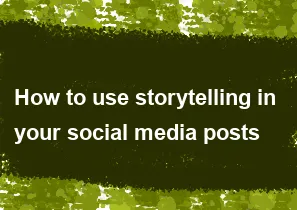How to use storytelling in your social media posts

Using storytelling in your social media posts can be a powerful way to engage your audience, create a connection, and convey your message effectively. Here are some tips on how to incorporate storytelling into your social media content:
Know Your Audience:
- Understand who your audience is, what they are interested in, and what resonates with them. Tailor your stories to match their preferences and demographics.
Start with a Hook:
- Capture attention right from the beginning with a compelling hook. This could be a question, a surprising fact, or a relatable situation that draws people in.
Keep it Concise:
- Social media platforms often have character or time limitations. Craft your story in a concise and impactful manner. Aim to convey the message effectively in a short span.
Create a Narrative Arc:
- Structure your story with a beginning, middle, and end. Introduce the situation or problem, build tension or interest, and then resolve or conclude the story.
Use Multimedia:
- Enhance your storytelling with visuals, such as images or videos. Visual elements can significantly enhance the emotional impact of your story.
Be Authentic:
- Share real and authentic stories. People connect more with genuine experiences, so don't be afraid to show vulnerability or share personal insights.
Involve Your Audience:
- Encourage engagement by asking questions or prompting your audience to share their own stories related to the topic. This can create a sense of community and participation.
Focus on Emotion:
- Appeal to emotions, as they play a crucial role in storytelling. Whether it's joy, empathy, or inspiration, make your audience feel something.
Consistency is Key:
- Develop a consistent storytelling style that aligns with your brand's voice and values. This helps in creating a cohesive and recognizable presence on social media.
Use Story Highlights:
- On platforms like Instagram, use the Story Highlights feature to save and organize your stories into categories. This makes it easier for your audience to access and revisit your narratives.
Utilize Storytelling Formats:
- Leverage different formats such as Instagram and Facebook Stories, Twitter threads, or LinkedIn carousels to tell longer or more complex stories.
End with a Call-to-Action (CTA):
- Finish your story with a clear call-to-action. Whether it's encouraging likes, shares, comments, or directing people to your website, guide your audience on what to do next.
Experiment with these storytelling techniques and adjust your approach based on the platform and your audience's feedback. The goal is to create engaging content that resonates with your followers and encourages them to connect with your brand on a deeper level.
-
Popular Post
- How to optimize for Google's About This Result feature for local businesses
- How to implement multi-language support in an Express.js application
- How to handle and optimize for changes in mobile search behavior
- How to handle CORS in a Node.js application
- How to use Vue.js with a UI framework (e.g., Vuetify, Element UI)
- How to configure Laravel Telescope for monitoring and profiling API requests
- How to create a command-line tool using the Commander.js library in Node.js
- How to implement code splitting in a React.js application
- How to use the AWS SDK for Node.js to interact with various AWS services
- How to use the Node.js Stream API for efficient data processing
- How to implement a cookie parser middleware in Node.js
- How to implement WebSockets for real-time communication in React
-
Latest Post
- How to implement a dynamic form with dynamic field styling based on user input in Next.js
- How to create a custom hook for handling user interactions with the browser's device motion in Next.js
- How to create a custom hook for handling user interactions with the browser's battery status in Next.js
- How to implement a dynamic form with dynamic field visibility based on user input in Next.js
- How to implement a dynamic form with real-time collaboration features in Next.js
- How to create a custom hook for handling user interactions with the browser's media devices in Next.js
- How to use the useSWRInfinite hook for paginating data with a custom loading indicator in Next.js
- How to create a custom hook for handling user interactions with the browser's network status in Next.js
- How to create a custom hook for handling user interactions with the browser's location in Next.js
- How to implement a dynamic form with multi-language support in Next.js
- How to create a custom hook for handling user interactions with the browser's ambient light sensor in Next.js
- How to use the useHover hook for creating interactive image zoom effects in Next.js